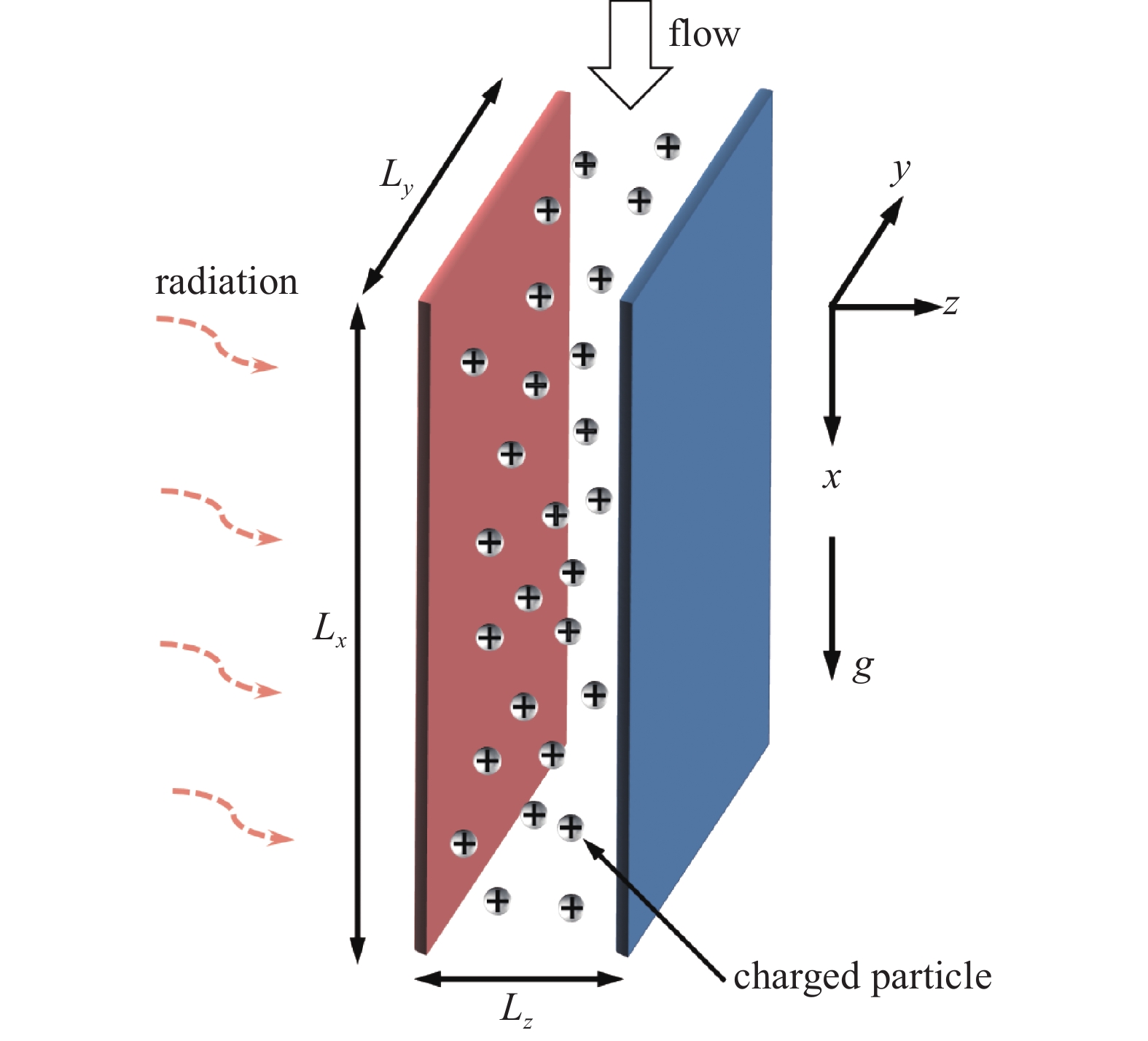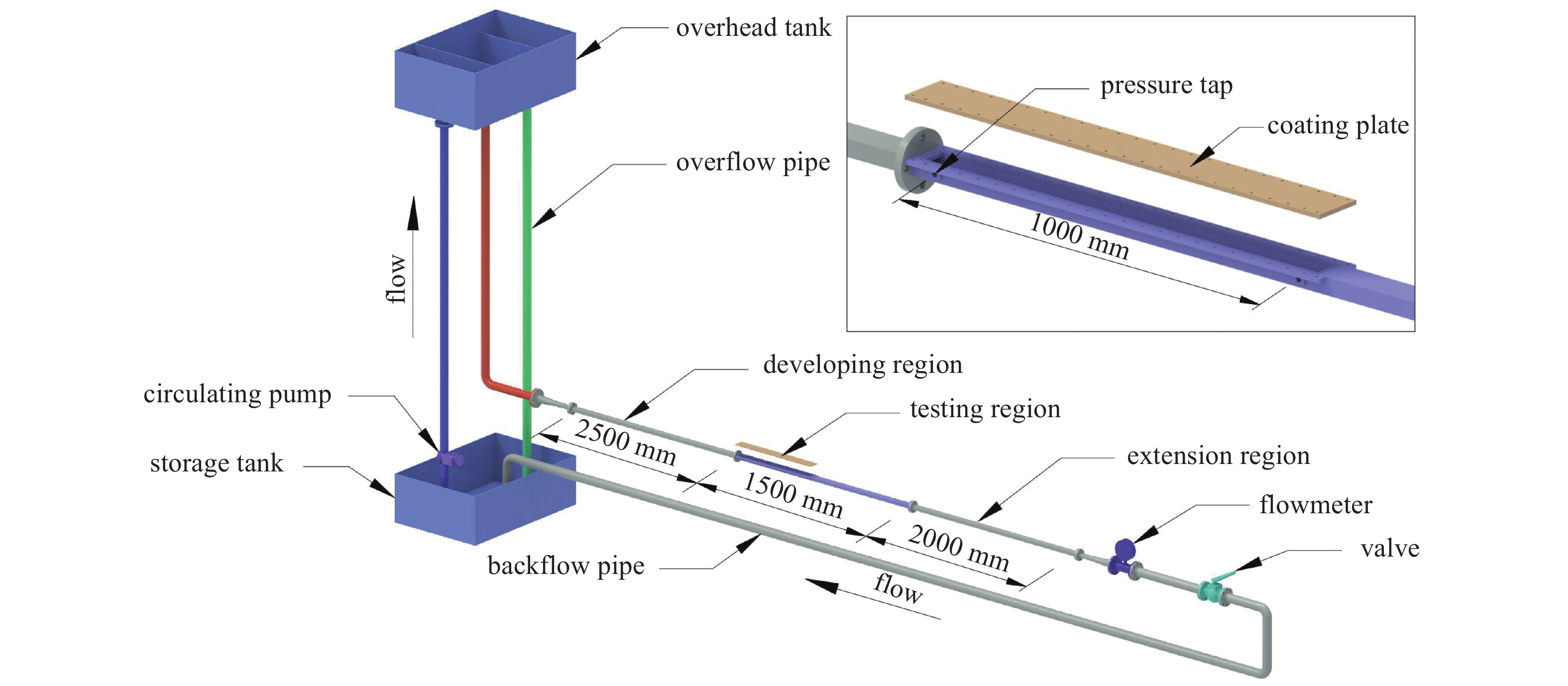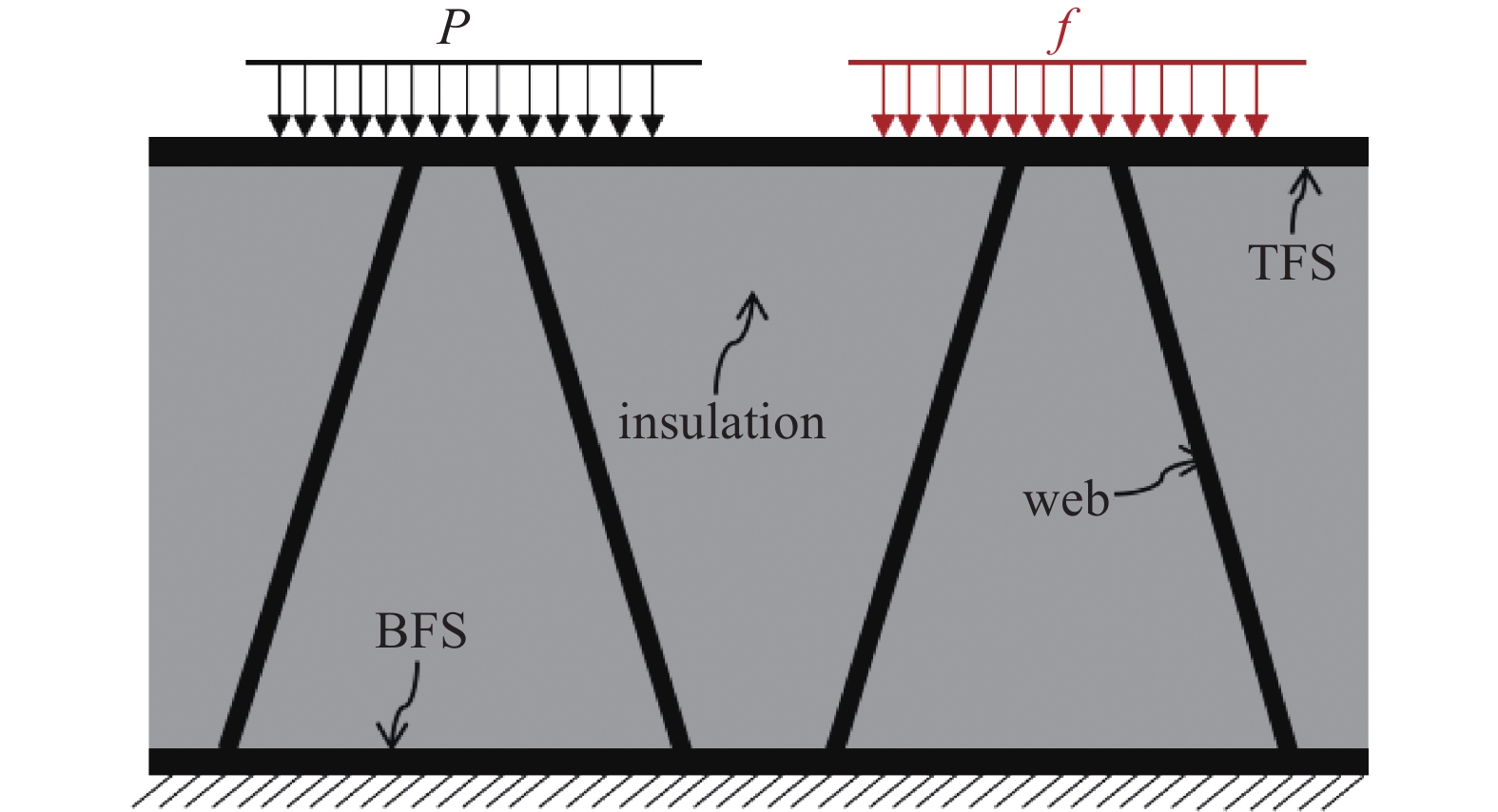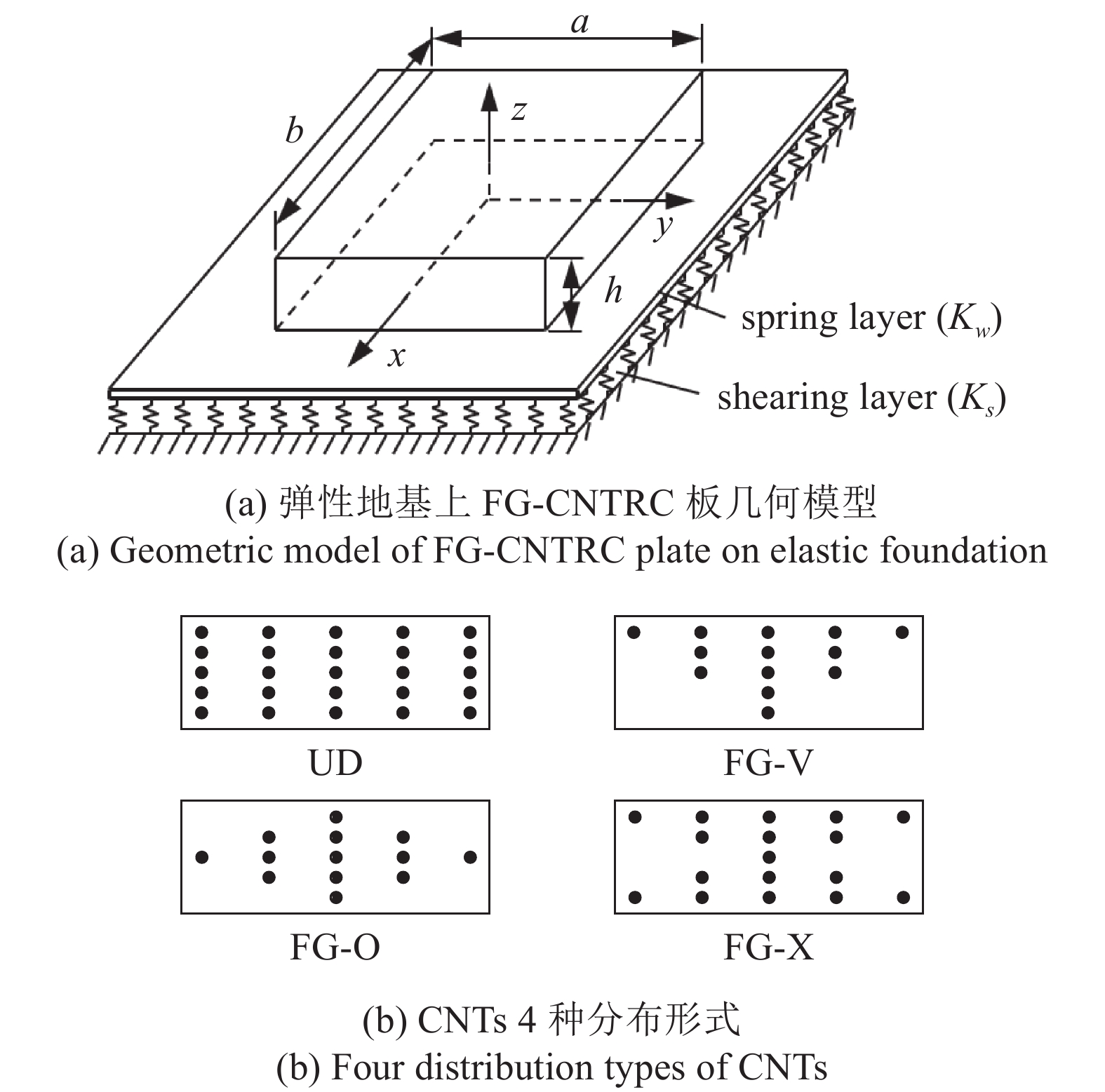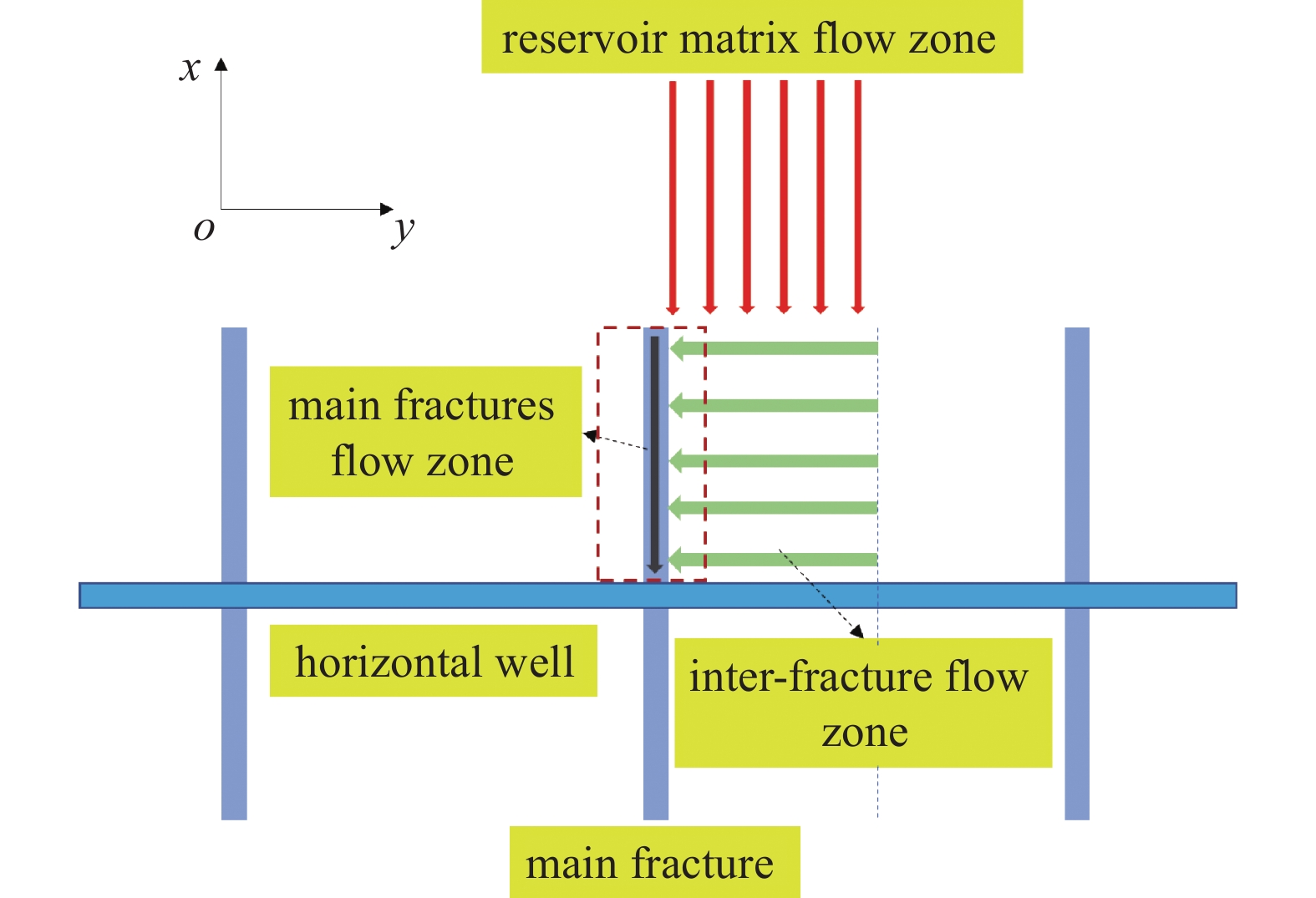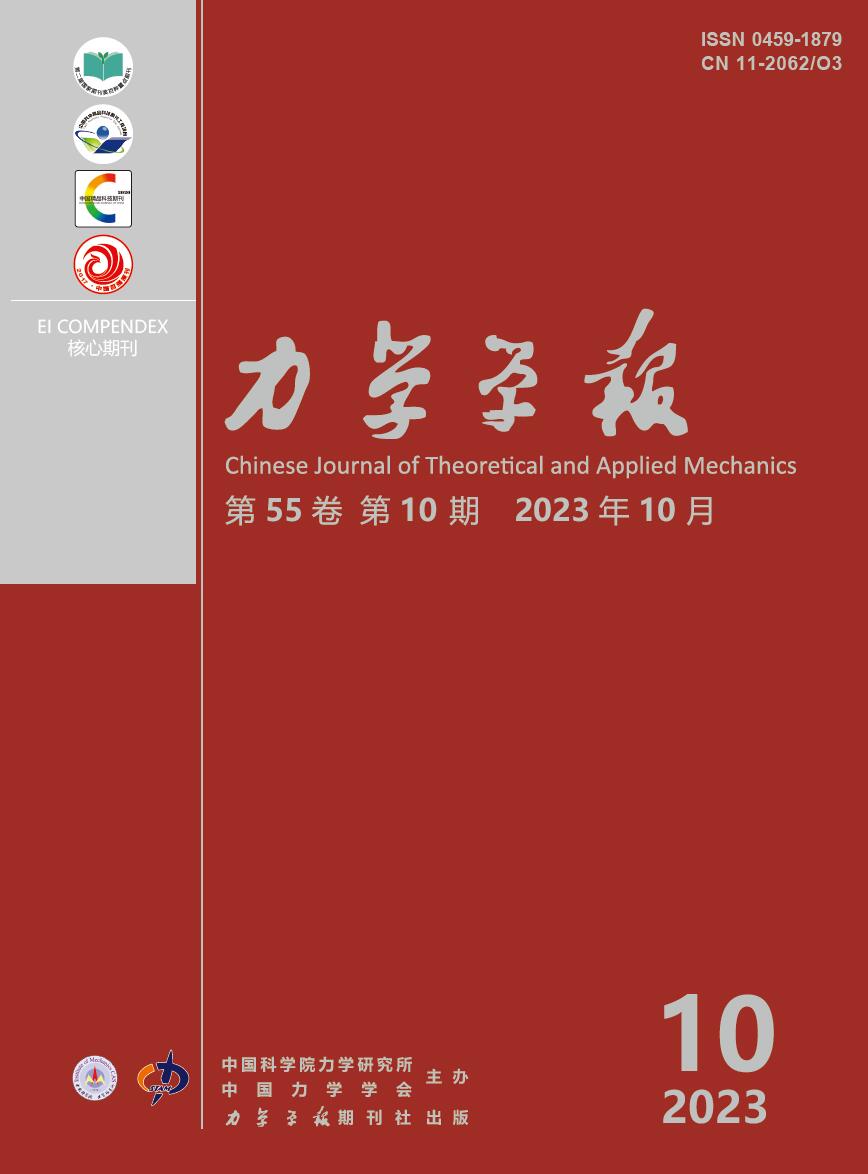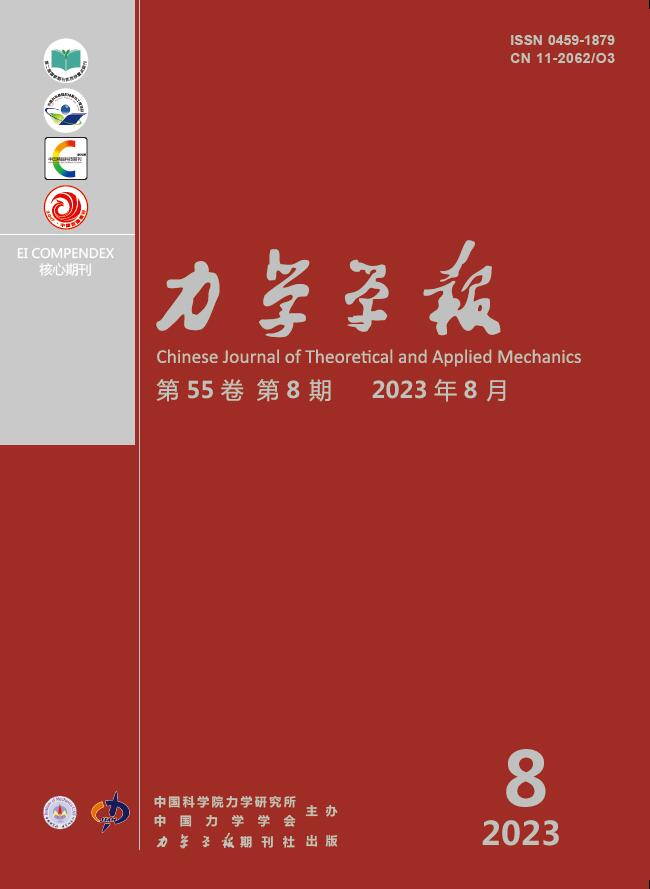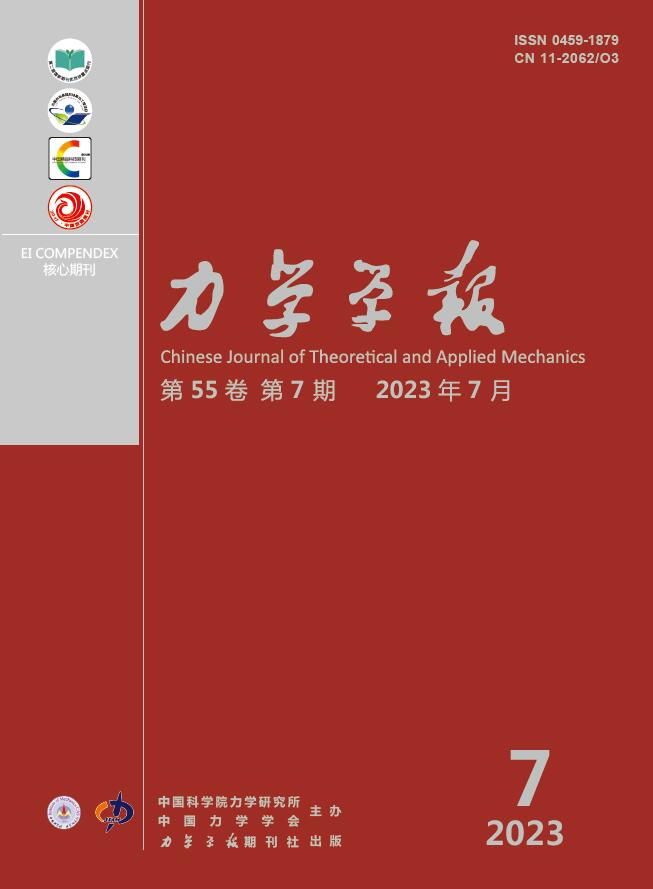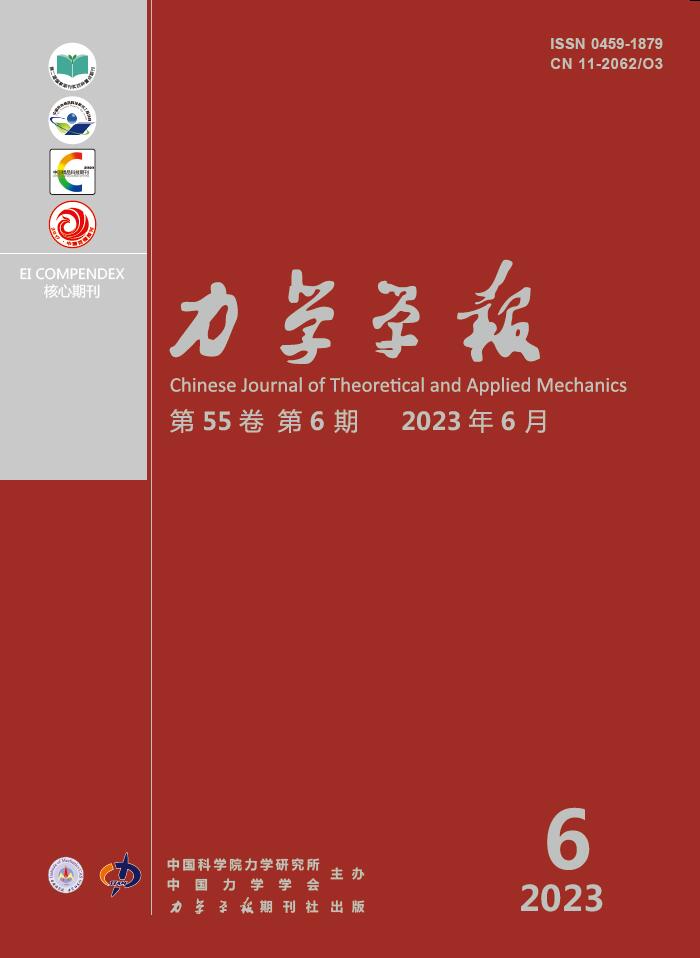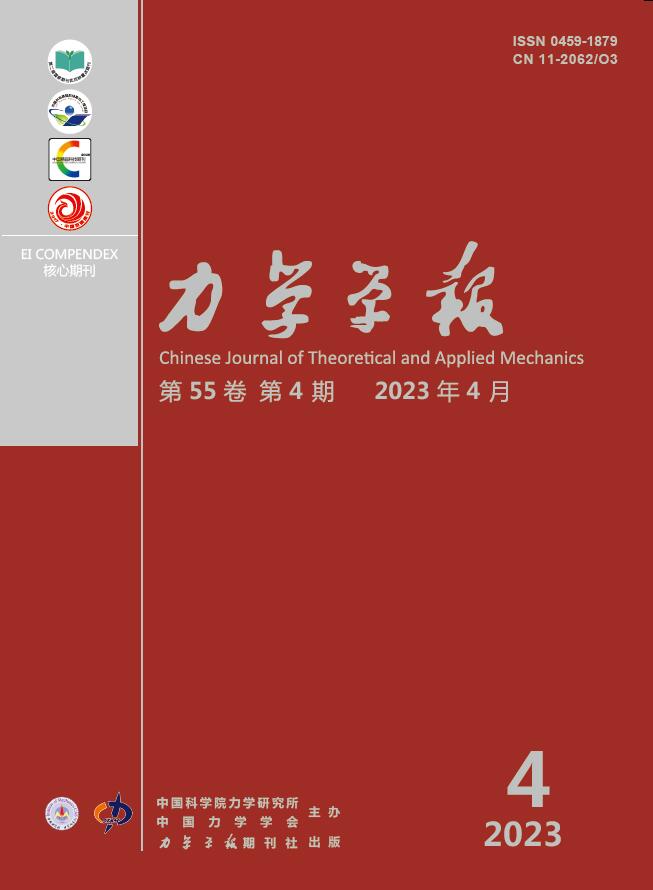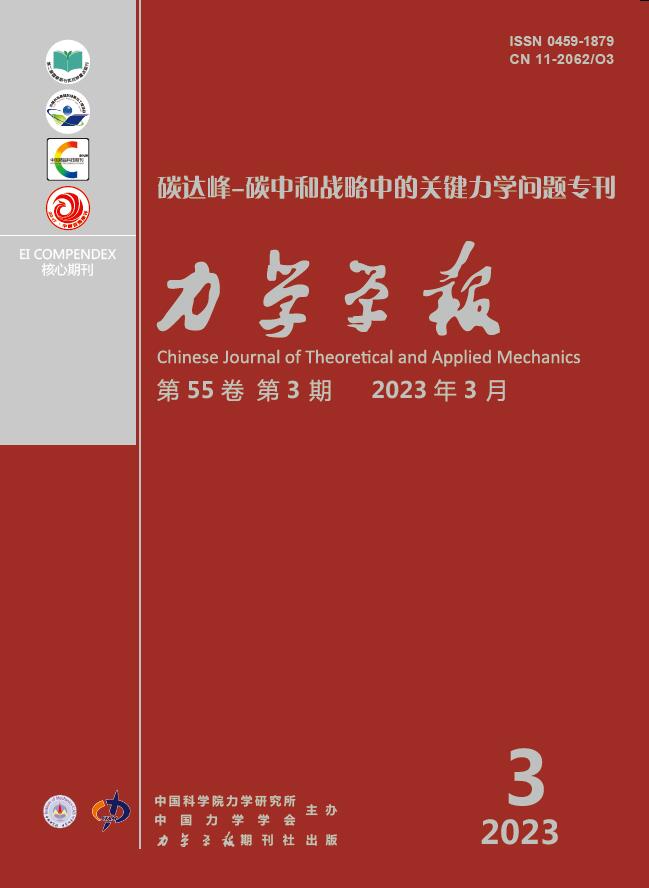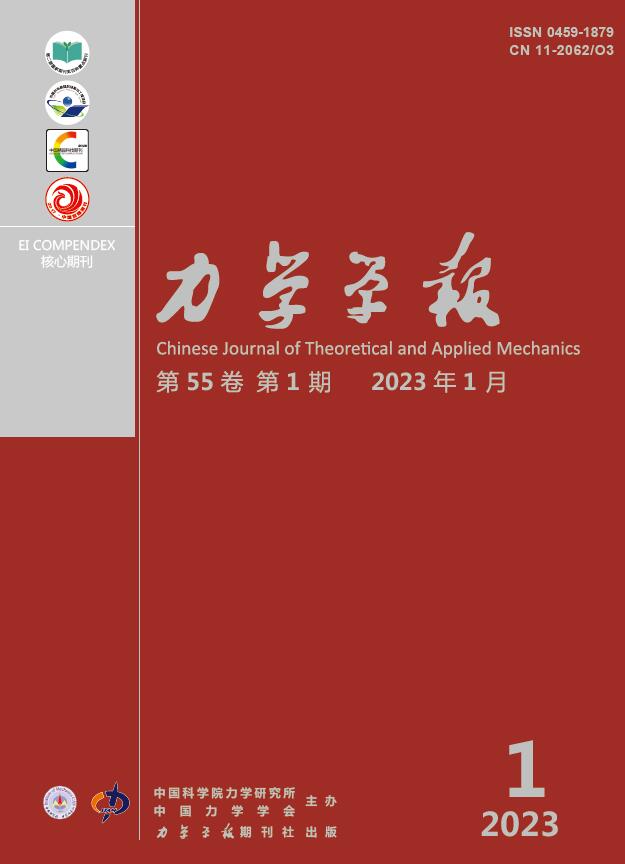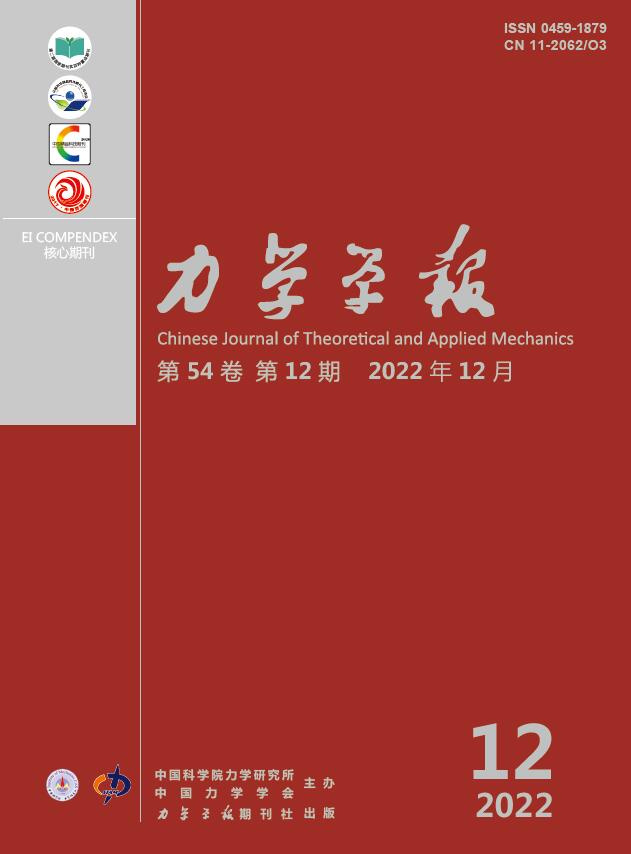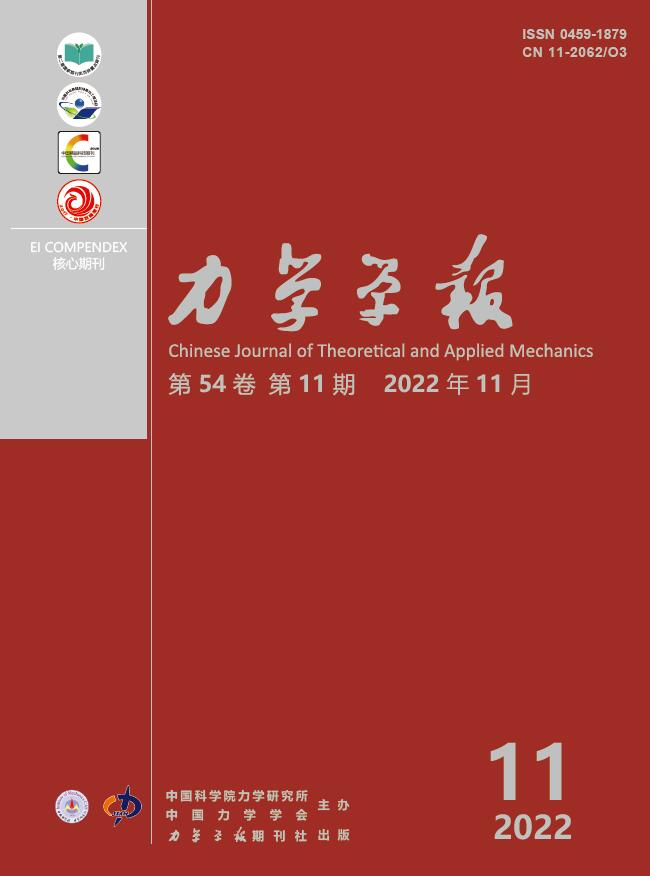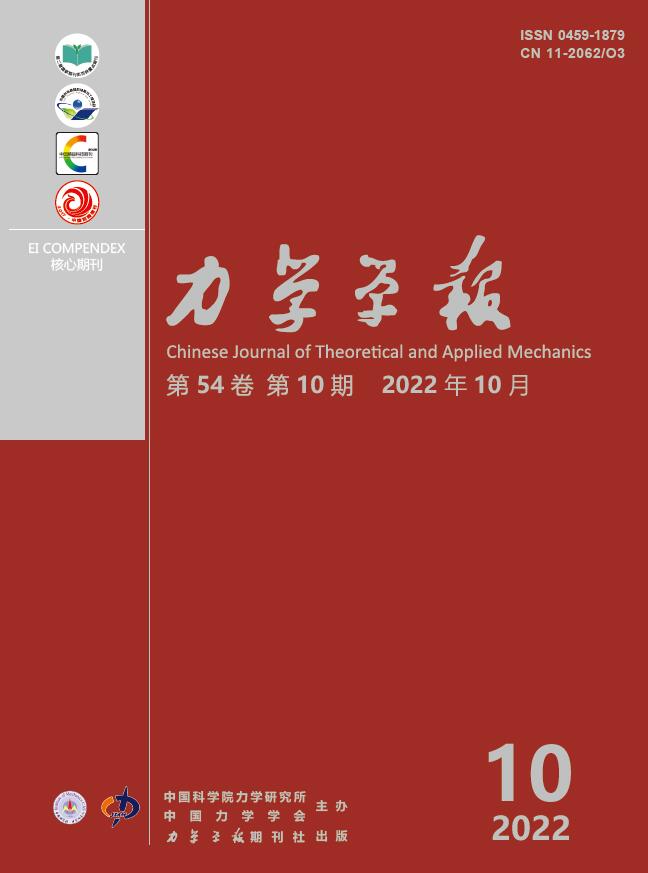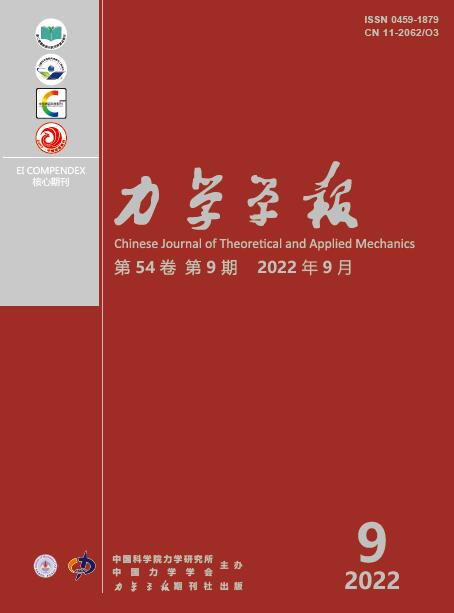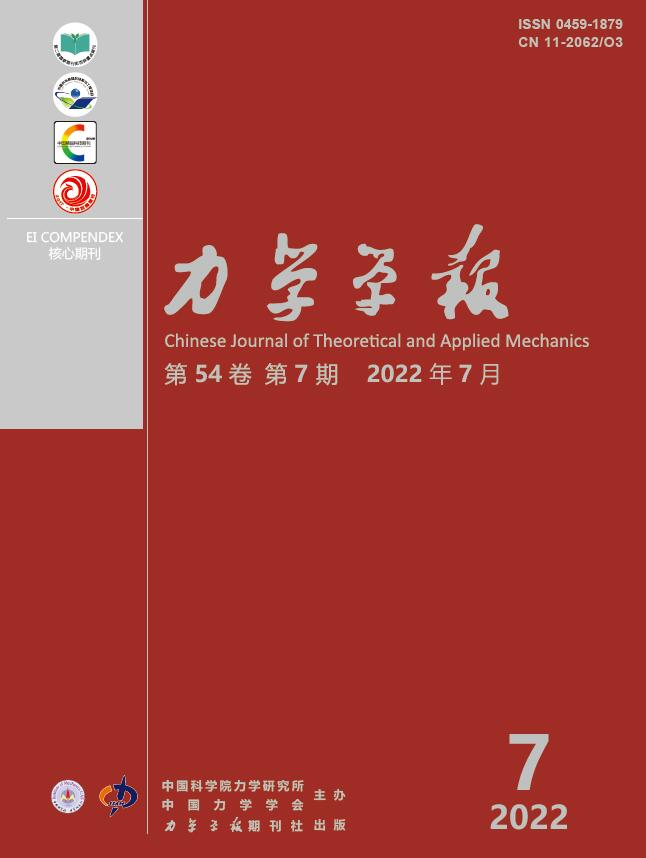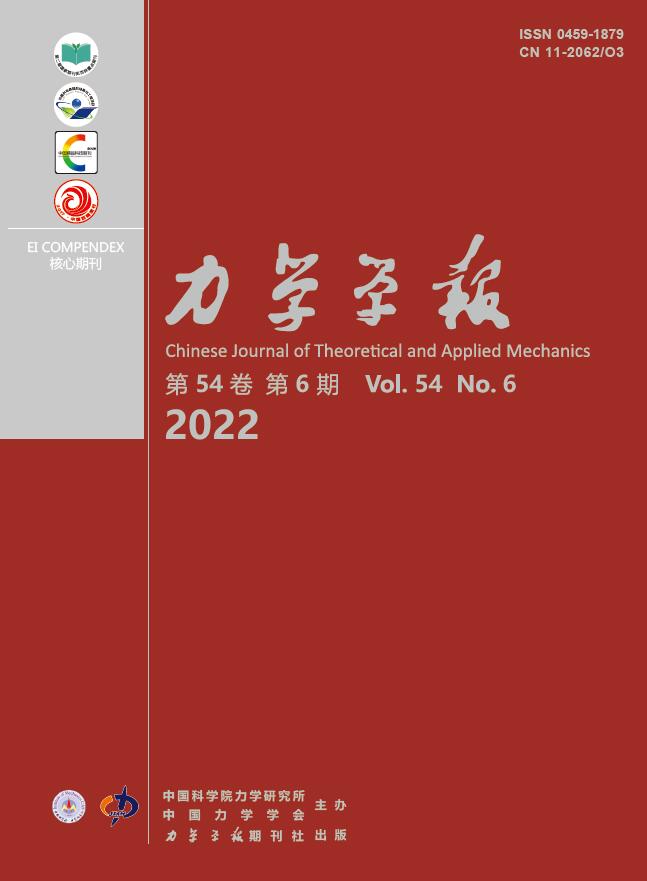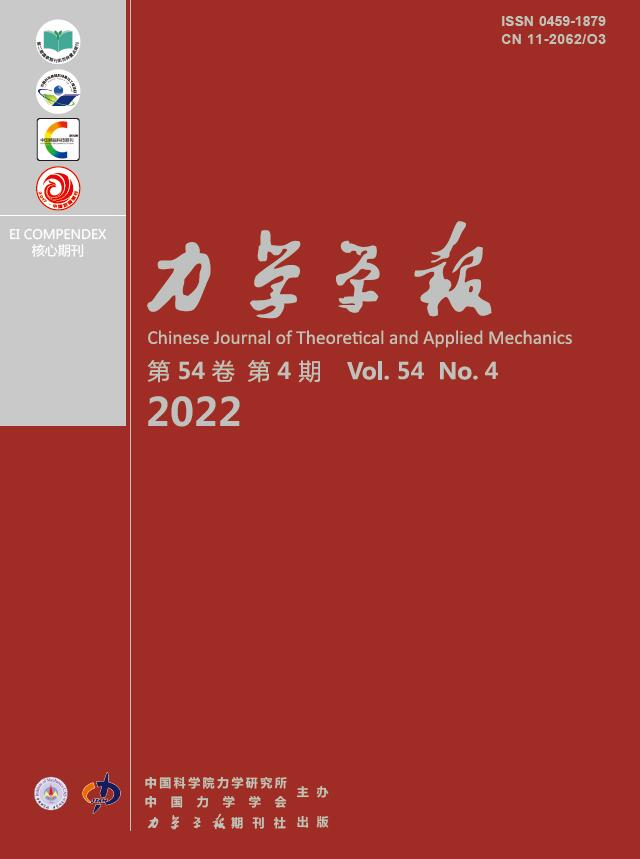2023, 55(10): 2091-2093.
doi:10.6052/0459-1879-23-498
Mechanical energy harvesting is a process of converting the scattered, disordered, low-quality, and high entropy mechanical energy from the environment into electrical energy. It enables self-powered IoT by powering low-power electronic devices such as widely distributed sensors. Mechanical energy harvesting exhibits the merits of flexible, convenient, sustainable, zero carbon, and environmental-friendly. It has become an international frontier research hotspot and can be widely applied in natural environment monitoring, infrastructure condition monitoring, equipment condition monitoring, etc. However, key issues are restricting the practical application of mechanical energy harvesting, such as low output power, narrow working frequency band, poor low-frequency effect, poor environmental adaptability, and low reliability. The dynamic regulation method for mechanical energy harvesting has the potential to enhance the performance of such systems by tailoring them to specific environmental stimuli and improving their output electrical performance. This paper constructs a dynamic regulation methodology system including excitation regulation, nonlinear systems, multi-degree of freedom systems, adaptive control and strategy regulation. The latest advancements in dynamic regulation methods has been discussed, including the characteristics and typical designs of each type of dynamic regulation method. Finally, the main challenges faced by dynamic regulation methods were summarized and the development trends were discussed. This paper provides a new perspective for adaptive dynamic regulation of mechanical energy harvesting systems in complex environments, which is beneficial for promoting the development of mechanical energy harvesting theory and technology.
2023, 55(10): 2094-2114.
doi:10.6052/0459-1879-23-341
Marine unmanned electromechanical systems such as marine environment sensors and vehicle/robots can be used for marine military reconnaissance, resource exploration, ecological monitoring, and status monitoring of large marine equipment and facilities, which is beneficial to marine ecological protection, marine economic development and protection of marine rights and interests. Long term effective energy supply is a bottleneck problem that restricts the operation of marine unmanned electromechanical systems in vast sea areas. The battery has limited power and pollutes the environment, while cable power supply not only has high costs but also limits the mobility of marine unmanned electromechanical systems. Wave energy is one of the most abundant renewable energy sources. The conversion of wave energy into electrical energy can be used for self-powered sensing, control, and driving of marine environmental electromechanical systems. It has the advantages of sustainability, flexibility, convenience, energy conservation, and environmental protection, and is expected to break the energy supply bottleneck of marine unmanned electromechanical systems. In addition, as fossil fuels face depletion and serious environmental problems, the development of marine energy can alleviate energy crises, reduce environmental pollution, and promote economic development. This paper comprehensively discusses the research progress of wave energy harvesting, self-powered marine unmanned electromechanical system based on wave energy harvesting and marine unmanned electromechanical system, discusses the key challenges and looks forward to it, provides a multi-dimensional reference for solving the long-term effective energy supply problem of marine unmanned electromechanical system, promotes the development and application of self-powered sensing, control and drive technologies, and helps the application of marine unmanned electromechanical systems in far-reaching sea areas.
2023, 55(10): 2115-2131.
doi:10.6052/0459-1879-23-334
In recent decades, with the rapid developments of IoT, there appear lots of independent low-energy -consumption electronic devices, e.g., the wireless sensors, portable medical devices, and microelectronic systems, how to provide reliable, clean and self-sufficient power for these devices is posing a great challenge. Providing power to distributed electronic devices through traditional chemical batteries is proving to be difficult. These batteries inherently possess a limited operational lifespan, and the exponential increase in the number of micro-electronic systems has consequently made replacement costs rise dramatically. Moreover, the disposal of the used batteries poses significant risks to the natural environment. In contrast, wind energy is a green energy, it also has advantages such as extensive distribution, substantial storage capacity, and non-pollution. Consequently, harvesting wind energy and converting it into electric energy have attracted wide attention. However, the current scheme of turbine generator is exhibiting some defects, e.g., it requires a great amount of capital, demands a place featuring plenty wind, produces noise in working, covers a large area, and poses a threaten to wildlife. Thus, how to harvest low-speed wind energy efficiently with simple and cheap structures becomes a hot topic of research. Wind energy harvesting based on vortex-induced vibration is emerging as one of the most attractive technologies. It is considered as a potential solution to realize self-powering of the distributed wireless sensors in IoT. In this paper, the research progress of vortex-induced vibration energy harvester is introduced from the aspects of working principle, research progress and promotion schemes. We review and discuss the effects of enhancing schemes, such as optimization of bluff body, introducing nonlinear restoring force, and designs of multidirectional and hybrid harvester, on the energy harvesting performance of vortex-induced vibration wind energy harvester. This review may provide a reference for the design of vortex-induced vibration energy harvesters and improvement of harvesting performance. Finally, according to the current research status, the key challenges are summarized and consulted. The future research direction and prospect are presented and discussed.
2023, 55(10): 2132-2145.
doi:10.6052/0459-1879-23-364
Wind-induced vibrations are a common occurrence in nature and have great potential as a viable energy source. Effectively harvesting energy from the structure’s large amplitude response caused by wind-induced vibrations can power microelectronic devices, however, it is still a significant challenge in the field of energy harvesting. In order to efficiently harvest wind-induced vibration energy, this paper proposes a magnetic sliding airfoil flutter energy harvester. A dynamic model of the harvester is established based on a semi-empirical nonlinear aerodynamic model and the electromechanical coupling coefficient related to the position of the magnets. An experimental prototype is created and a wind tunnel test platform is built. In the experiment, by increasing and decreasing the wind speed, two different initial states are provided for the harvester, and two cut-in wind speeds are discovered 5.2 m/s and 8.3 m/s. A sudden jump phenomenon occurs at 8.3 m/s in downward sweeping wind speed experiments. Two jump points and a multi-solution region are found at 6.8 m/s and 8.2 m/s in numerical simulations. The displacement response exhibits a sine waveform, while the output voltage shows a non-sinusoidal waveform with significant even-order harmonics. The simulated plunging displacement and voltage output waveform closely match the experimental waveform, confirming the accuracy of the model. The output root mean square voltage of the energy harvester increases with the increase of resistance, and the average power shows an increasing-then-decreasing trend with resistance. An analysis is conducted on the impact of load resistance on energy harvesting performance. At the wind speed of 8.6 m/s, the average power in the experiment reaches its maximum value of 7.5 mW when the load resistance is close to the coil’s resistance. Overal, this article provides a new design approach for efficient flutter-based energy harvesters, offering a reference for the design of other forms of wind-induced vibration energy harvesters such as galloping-induced and vortex-induced vibration.
2023, 55(10): 2146-2155.
doi:10.6052/0459-1879-23-330
The bottleneck in the rapid development and widespread deployment of the Internet of Things (IoT) is how to power tens of thousands of sensor network nodes in an efficient and cost-effective way. The conversion of vibration energy into electrical energy for self-powering of the sensor is a very feasible solution. However, low-frequency components make up a large proportion of environmental vibrations, and traditional vibration energy harvesting methods have difficulty in efficiently converting low-frequency ( < 10 Hz) vibration energy, which limits the widespread use of vibration energy harvesting technology in the field of IoT. In this paper, a quasi-zero-stiffness-enabled piezoelectric vibration energy harvester (QZSE-EH) is proposed for the harvesting of the ultra-low frequency energy from the environment, human body and some mechanical devices. At first, the electromechanical coupling equation of the energy conversion unit is obtained by using the energy method, and the dynamic and electrical response equations are solved by using the harmonic balance method. The effect of the damping ratio and the excitation amplitude is explored by means of the results of the analytical solution. Finally, a prototype of the QZSE-EH was fabricated and the experiment was carried out to verify the correctness of the dynamic and electrical output response of the system. The results show that when the frequency is 2.5 Hz, the maximum peak voltage of a single energy conversion unit in the QZSE-EH reaches 25 V. The QZSE-EH proposed in this paper is expected to overcome the problem that the operating bandwidth of conventional resonant piezoelectric energy harvesters depends on the natural frequency, and the multi-stable energy harvesters are unable to cross the barrier, making ultra-low frequency and low-amplitude energy harvesting extremely difficult. This paper provides a new idea for the efficient harvesting of ultra-low frequency and low-amplitude vibration energy, and can further consolidate the theory of vibration energy harvesting.
2023, 55(10): 2156-2167.
doi:10.6052/0459-1879-23-315
At present, most energy harvesters can only collect less energy from low-frequency motion, with low energy collection efficiency. Low power generation under low-frequency excitation is becoming the key issue that currently limits the application of electromagnetic energy harvesters in multiple scenarios. Electromagnetic induction power generation, as a widely used and mature power generation technology, has higher power output and is widely used in the field of energy harvesting, which is expected to solve this technical bottleneck. This paper proposes an electromagnetic vibration energy harvester based on a helical clutch transmission system to systematically solve the problem of low output frequency of the energy harvesting and short conversion time. The mechanical transmission system of the harvester is composed of three parts: a linear-rotation conversion module, a helical clutch module and an energy storage/release module, which can convert external low-frequency and irregular instantaneous excitations (about 0.2 ~ 5 Hz) into high-frequency, continuous unidirectional rotational motions to maximize energy conversion efficiency. An electromechanical coupling dynamics model was established for the proposed energy harvester and verified by experiments. The results show that the energy harvester can realize the output of the open circuit state for up to 30 s under the external pulse excitation; the maximum rotational speed of the inertial rotation motion after connecting the load can reach 750 r/min, and the motion frequency can achieve a nearly 300 times improvement from 0.17 ~ 50 Hz. the peak power of a monolayer power generation module can reach 1.25 W, and that of bilayer power generation modules connected in parallel can be 2.5 W, which can achieve an average power of 134 mW. In addition, its compact and efficient transmission structure design enables the energy harvester to be further integrated into wearable devices, which is of great significance in the field of human energy harvesting and the construction of self-powered IoT sensor nodes.
2023, 55(10): 2168-2177.
doi:10.6052/0459-1879-23-362
By reasonably designing the pendulum length, the natural frequency of a pendulum structure can be effectively reduced, so that it can realize resonance under low frequency (even ultra-low frequency) vibration excitation, and then greatly improve the energy conversion performance. The pendulum-type triboelectric nanogenerator (P-TENG) has naturally become the focus of academic attention. In this study, nonlinear electromechanical coupling modeling and parameter sensitivity analysis are conducted to optimize the structural design of the P-TENG, so as to promote its development towards engineering practicability. Based on the analysis of power generation mechanism, an equivalent capacitance model is proposed. Combined with the energy principle and equivalent circuit method, an electromechanical coupling model considering the nonlinear variation of pendulum angle is established. Using the harmonic balance method and alternated frequency/time domain technique, the steady-state output of the P-TENG is solved analytically, and the stability of the results is determined. Numerical integration and dynamic tests are conducted to verify the accuracy of analytical model. The results are compared with the linear model and the influence of various design parameters on the output characteristics of the P-TENG is investigated. Considering the nonlinear effects, the estimated operating bandwidth of the model increases significantly (by a relative increment of 83%). The proposed model can effectively avoid the underestimation of the operation bandwidth and significantly improve the accuracy of the P-TENG performance estimation. Increasing the excitation amplitude, reducing the damping ratio, and minimizing the electrode angle can improve the output performance of the P-TENG. Various fitting models have been proposed to model the relationship between design parameters and output performance. The fitting coefficients obtained from the parameter influence discussion can be used as the basis for the P-TENG output performance design.
2023, 55(10): 2178-2188.
doi:10.6052/0459-1879-23-197
The phenomenon of multiphase flow in porous media occurs widely in both natural and industrial applications, including groundwater flow, oil and gas development, and unsaturated particulate materials. Liquid bridges play a crucial role in these processes and significantly influence the dynamics of multiphase flows. In this work, we have investigated the effect of liquid bridges on spontaneous liquid-liquid imbibition in capillaries based on a modified spontaneous liquid-liquid imbibition theory model and a two-component Shan-Chen model with an improved fluid-solid interaction force format. The results indicate that the presence of liquid bridges leads to the formation of three interfaces within the capillary, which significantly increases the dynamic contact angles of the entire system and reduces the rate of spontaneous imbibition compared to processes without liquid bridges. Additionally, with the increase of wettability, the presence of liquid bridges enhances the dynamic interface change characteristics more strongly. When the viscosity of the liquid bridge is lower than that of the non-wetting fluids, an increase in the imbibition length will enhance the dynamic contact angles of the entire system; if they both have equal-sized viscosities, then the dynamic contact angles of the entire system remain a constant; and when the viscosity of the liquid bridge is larger than that of the non-wetting fluids, there is a gradual decrease in the dynamic contact angle during imbibition. By incorporating the real-time dynamic contact angle obtained from the simulation into the imbibition theory, the deviation between the theoretical and simulated imbibition lengths due to the dynamic changes of the liquid-bridge interface can be improved, and the results are consistent with the simulation. In this study, we also systematically evaluated the predictive ability of Cox-Voinov models for interface dynamic variation and imbibition length in imbibition processes with and without liquid bridges by using the data from the simulation.
2024, 56(2): 258-272.
doi:10.6052/0459-1879-23-444
Deep learning, characterized by its multi-layer neural networks, has demonstrated its capability not only to uncover hidden information in data but also to effectively address complex nonlinear problems. As a fundamental mathematical model, partial differential equations (PDEs) find wide application in describing various physical phenomena in the natural world. The amalgamation of deep learning and PDEs has given rise to the emergence of intelligent PDE solving methods based on deep learning. These methods possess several advantageous traits, including high efficiency, flexibility, and universality, which make them valuable in practical applications. This paper focuses on intelligent PDE solving methods, categorizing the solving approaches into two types based on whether they handle single or multiple problems: neural operator methods and physics-informed neural network (PINN) methods. Neural operator methods are employed to solve a class of PDE problems with the same mathematical characteristics, while PINN-based methods are used to solve single problems. The first category encompasses neural operator methods, which are utilized for solving a group of PDE problems that share similar mathematical characteristics. These methods leverage data-driven approaches and physical-constraint approaches to formulate their solutions. An in-depth analysis is conducted to examine the current research status, along with the identification of existing drawbacks in these approaches. As for PINN-based methods, this paper introduces the relevant research progress from three derivative approaches of PINN (data-optimization, model-optimization, and domain-knowledge-optimization). Finally, this paper provides a comprehensive overview of the technical roadmap for PDE intelligent solving methods. It critically evaluates the existing research limitations and proposes feasible research plans to overcome these challenges. Additionally, the paper briefly introduces the current state of intelligent solving program development and offers suggestions for future research directions. By amalgamating deep learning and PDEs, these intelligent solving methods have the potential to revolutionize various scientific and engineering domains, enabling more accurate and efficient problem-solving in complex nonlinear systems.
2024, 56(2): 1-15.
doi:10.6052/0459-1879-23-407
Helicon plasma is one of the highest density plasma sources for generating the low-temperature plasma nowadays. It has great application potential in the fields of material processing, thin film deposition, aerospace propulsion, magnetic confinement fusion, and basic plasma physics research. It has received extensive attention from researchers worldwide in recent years. However, people lack in-depth understanding of the discharge theory of helicon plasma. There are various hypotheses about the absorption of energy during plasma excitation and propagation. It is more recognized that energy deposition is achieved by coupling the helicon wave and TG wave in the helicon plasma. At the same time, many unique phenomena, such as low-field peak, mode transition, current-free double layer (CFDL), have been demonstrated during the helicon plasma discharge process, which cannot be explained uniformly. It is sure that the investigation on the discharge characteristics will help to deepen the understanding of the discharge mechanism of helicon plasma. In this paper, the basic research progress on helicon plasma in the past 15 years was reviewed from the aspects of discharge mechanism and discharge characteristics. The results of low-field peak phenomenon, mode transition, and CFDL phenomenon during helicon plasma discharge were summarized. Focusing on the research on the discharge characteristics of helicon plasma, the future directions were prospected, which provides support for understanding the coupling mechanism of helicon plasma discharge and realizing engineering applications.
2023, 55(12): 2786-2800.
doi:10.6052/0459-1879-23-348
A large number of free electrons and ions can be generated by high voltage breakdown of the gas, forming a gas discharge plasma that is roughly electrically neutral to the outside world, while various processes initiated by energetic particles produce a rich variety of reactive substances in the plasma. Atmospheric pressure low-temperature plasma has non-equilibrium characteristics, and therefore maintains high reactivity at low gas temperatures. When an atmospheric pressure low-temperature plasma is in contact with a solution, a plasma electrochemical system can be formed. Charge and substance transfer at the plasma-liquid interface can lead to a series of physicochemical and electrochemical processes, which makes the plasma electrochemical system widely used in a variety of fields, and the synthesis of nanomaterials is one of the many applications. Currently, there have been a large number of studies on the synthesis of nanomaterials using plasma electrochemistry, and there are also related review articles, but there is a lack of reviews focusing on gold and silver nanoparticles and carbon quantum dots, so here we review the results of the research on the synthesis of gold and silver nanoparticles and carbon quantum dots using plasma electrochemistry in recent years. Firstly, we introduce the plasma electrochemical method, then we examine the experimental results of the synthesis of gold and silver nanoparticles and carbon quantum dots and the progress of their applications, and finally we discuss the problems and challenges encountered in the current research and try to propose solutions.
2023, 55(12): 2722-2738.
doi:10.6052/0459-1879-23-346
The development of a new-generation near space hypersonic vehicle towards whole aerospace and higher Mach number, which result in increasingly harsh aerothermal environments. Aerothermal environment prediction is one of the key technologies in the design of these near space hypersonic vehicles. During hypersonic flight, the kinetic energy is transformed into internal energy because of the strong shock wave and viscious retardation that is created around a vehicle. These generates a high enthalpy air flow and therefore shock layers is the site of intensive physics chemical non-equilibrium processes. A large amount of aerodynamic physical phenomena are involved in the study of the properties of high temperature gas flow fields. The excitation of the internal modes of vibration and electronic, and the gas quickly dissociate, recombine and ionization can create significant ionized particles, which makes the aerothermal environment prediction face all kinds of challenges. The development of high temperature thermochemical non-equilibrium aerothermal prediction technique is analyzed and discussed. First, a brief development history of high temperature aerothermal ground experiment technique is reviewed, the capabilities of aerothermal prediction ground wind tunnel and the research level of measurement technique are emphatically analyzed and introduced. Then, the aerothermal numerical simulation prediction technique are introduced, and the aerothermal numerical simulation law of thermochemical non-equilibrium flow field is discussed from the perspectives of thermochemical, radiation transport, wall catalysis and ablation. Finally, the development trend of aerothermal prediction technique is discussed, and the problems should be solved in the future of high temperature aerothermal test and simulation technique are also proposed.
2023, 55(11): 2439-2452.
doi:10.6052/0459-1879-23-196
The harmonic balance method is the most commonly used method for solving periodic solutions of nonlinear dynamic systems, but the high-order approximation of nonlinear terms requires sophisticated formula derivations, which limits its ultra-high accuracy computation. The authors' team proposed the reconstruction harmonic balance (RHB) method through the equivalent reconstruction of the frequency domain nonlinear quantity in the time domain, which successfully conquered the problem of ultra-high-order calculation of the classical harmonic balance method. However, both two methods require the dynamical system to be polynomial nonlinear, and cannot be directly used to solve the quasi-periodic solution of the nonlinear system. In view of the above problems, this paper proposes a novel method that combines the RHB method and the recast technique for complex nonlinear systems. First, the general nonlinear problem is non-destructively recast into a polynomial nonlinear system, and then the RHB method is used for high-precision solutions. Aiming at computing the quasi-periodic response, which is hard to obtain relatively accurate results by considering only one base frequency, the RHB method based on the idea of "supplemental frequency" is derived. By optimizing and selecting base frequencies, the fast and accurate capture of quasi-periodic response is achieved in this paper. The typical systems such as the nonlinear pendulum, and the nonlinear coupling asymmetric pendulum are selected for simulation and algorithm verification. Simulation results show that the accuracy of the proposed RHB-recast method achieves an accuracy up to 10−12when solving the non-polynomial type nonlinear systems, reaching the computer round-off-error accuracy, far exceeding the state-of-the-art methods. The supplemental frequency RHB method has been shown to produce efficient solutions for quasi-periodic problems, expanding the scope of the RHB-like methods for solving complex physical responses.
2024, 56(2): 1-13.
doi:10.6052/0459-1879-23-369
NUMERICAL SIMULATION RESEARCH OF SOLID-LIQUID TWO-PHASE FLOW IN VERTICAL PIPE UNDER FORCED VIBRATION
The transportation of coarse-particle solid-liquid two-phase flow in pipes is applicable to deep-sea mining engineering. The transport mechanism of internal solid-liquid two-phase flow in riser pipes under flow-induced vibration has not been fully explored. Therefore, this study employs a coupled computational fluid dynamics (CFD) and discrete element method (DEM) approach to analyze the dynamic characteristics of coarse particles and the variations in the flow field characteristics under forced vibration conditions in pipes with varying particle sizes, different vibration frequencies and amplitudes, and different concentrations. In this analysis, the pipe vibration is simplified as one-dimensional radial vibration, and flexible pipes in practical situations are assumed to be rigid pipes. Research indicates that during pipe vibration, larger particles exhibit greater inertia compared to smaller ones, and the fluid must attain higher velocity to generate increased drag force necessary for propelling these larger particles, resulting in higher axial flow field velocity and greater axial particle velocity. As the particle size increases, larger particles induce more significant perturbations in the flow field, leading to increased forces between the fluid and the pipe wall; additionally, larger particles experience more substantial collisions and frictional forces with the pipe wall, thus amplifying wall shear stress. Simultaneously, the energy dissipated due to frictional losses between larger particles and the fluid is also greater. Consequently, a higher energy input is required to transport these particles, leading to an increase in pressure drop within the vibrating pipe. Increasing the pipe vibration frequency and amplitude leads to a more dispersed particle distribution across the cross-section and greater disturbance to the flow field, albeit with a relatively minor impact on axial flow field velocity. Higher feed concentrations result in more frequent interactions between particles and between particles and the flow field, causing changes in particle distribution and leading to increased axial flow velocity and turbulence kinetic energy.
2024, 56(2): 221-231.
doi:10.6052/0459-1879-23-357
Nanoporous metals are a type of metallic material that contain a large number of nanoscale pores. These materials are characterized by their outstanding surface effects and exhibit superior mechanical properties compared to traditional porous metals. Compared with theoretical and molecular dynamics simulations, finite element methods are more suitable for complex structural models. However, limited by theoretical difficulties, previous research has often simplified the models of nanoporous metals into relatively simple two-dimensional structures, which cannot provide an accurate depiction of their mechanical properties. Therefore, this study employs the principle of minimum energy and the surface theory of nano-materials to develop a finite element surface element that considers the surface effect of nanoporous materials. By considering the non-uniformity of the microscopic structure, we further develop a finite element computational model that enables the analysis of the mechanical behavior of three-dimensional nanoporous metal materials. We verify the effectiveness of our developed finite element model by comparing the calculated stress distribution near the nano-pores with the reference literature. Using the developed computational model, we perform single-axis tension and compression simulations on nanoporous metal materials containing either single spherical pores or random multiple spherical pores, and investigate the influence of porosity, pore quantity, and surface parameters on the Young's modulus, yield strength, and energy absorption capacity of nanoporous metals. Our results demonstrate that the developed finite element model can accurately capture the stress distribution near the nano-pores. Furthermore, our findings indicate that the Young's modulus of nanoporous metals significantly depends on the residual stress on the pore surface and the loading direction, rather than the surface Lamé constant. In summary, the developed finite element model provides a scientific evidence for the mechanical performance prediction of nanoporous metals.
2023, 55(11): 2554-2565.
doi:10.6052/0459-1879-23-155
The non-synchronous vibration (NSV) of compressor rotor blades is a new type of aeroelastic problem discovered in recent years, the characteristics is manifested as the non synchronization between the vibration frequency and the rotating frequency and exhibiting frequency locking phenomena, which seriously affects the reliability and operation safety of aeroengine. Currently, the mechanism is not fully understood. In order to deeply investigate the interaction mechanism between the unstable flow and non-synchronous vibration of blades, a time domain fluid-structure interaction method of multistage compressor full-annulus rotor blades was established, the unsteady flow field, aerodynamic excitation frequency and structural response characteristics of rigid and flexible blades were numerically studied to reveal the fluid-structure interaction mechanism of NSV. The results indicate that the periodic shedding and reattachment process of radial separation vortices on the tip suction surface causes the severe pressure fluctuation under near stall conditions. Its three times harmonic aerodynamic excitation frequency is close to the first-order bending natural frequency and provides the initial aerodynamic excitation for the NSV. During the NSV, the displacement response of rotor blade exhibits equal amplitude limit cycle oscillation, and dominated by the first-order bending model. The non-integer multiple aerodynamic excitation and its harmonic frequencies generated by radial separation vortex are ultimately locked-in the first-order bending natural frequency. The motion stress of NSV causes the circumferential flow field of adjacent channels to become consistent. This present result and the mechanism understanding of fluid-structure interaction of NSV can provide useful references for the analysis of blade vibration failure induced by unstable flow in compressor.
,Available online,
doi:10.6052/0459-1879-23-435
The combustion process of ammonia causes high NOx emissions. In order to reduce NOx emissions, the fuel staging strategy was applied in NH3/dimethyl ether combustion. In this work, the emission characteristics of NH3/DME flames were investigated in an experimental fuel staging combustor. It was found that the NO and NO2 concentration in exhaust decreased when the fuel staging strategy was used. The maximum reduction rates of NO and NO2 were 60.1% and 88.7%, respectively. NH3 was almost completely consumed under single stage combustion, but it was emitted when fuel staging method was used. The concentration of NH3 in exhaust increased with the increase of secondary NH3 injection flowrate, while the trend of the NO concentrations was opposite. The emission concentrations of NOx and NH3 were observed to reach relatively low values (around 3000 ppm) simultaneously at φpri=0.85 when the thermal power of the combustor was 0.6 kW. The experimental results showed that the globally lean-locally lean two-stage combustion strategy has a promising application prospect in NOx reduction. Then, the numerical study was conducted in the chemical reactor network (CRN) to further analyze the NO emission behaviors of NH3/DME fuel staging combustion. It was showed that the CRN model captured the trend of NO emission accurately. The results of NO sensitivity analysis showed that the DME is more active than conventional hydrocarbons and has a significant promoting effect on NO production. The ROP analysis showed that NO was mainly generated through HNO pathway at the primary stage zone, and consumed through the reactions NH2+NO=N2+H2O and NH2+NO=NNH+OH at the secondary stage zone.
,Available online
When the gas of basic oxygen furnace (BOF) is about 850℃, water spray is generally used for cooling and dedusting, resulting in 50% of the sensible heat of the gas being wasted. The all-dry sensible heat recovery system of the converter gas cancels the water spray process, which can make full use of the waste heat resources of CO rich gas in the BOF steelmaking process. However, there is an explosion risk in the pre-burning/post-burning stage of the gas of BOF. In order to ensure the safe and stable operation of the system of all-dry process, the experiments and calculations were used to study the effects of CO equivalence ratio, mass flow rate, air moisture and mixing temperature on CO deflagration characteristics. The results show that the maximum pressure of CO deflagration decreases with the decrease of CO equivalent ratio in the mixed gas. Within the range of experimental CO equivalent ratio, the maximum value of deflagration pressure is 0.65 MPa. The increase in the temperature of the mixture results in the decrease of the pressure of deflagration, while the flame speed relatively increases, thereby affecting the flame propagation time.The increase in water content will increase the maximum pressure of CO deflagration, but the increase of water content after 0.463% has little effect. Finally, by analysing the characteristics of CO deflagration and the actual process, the combustion control and enhancement methods, as well as the explosion suppression methods and technologies are proposed.
,Available online
The beam structures play a very important role in the engineering industry. The free vibration problem of beams reflects their basic dynamic characteristics, which is also a vital problem in the dynamics analysis. The classical beam theories are often based on different assumptions. The present paper uses the asymptotic analysis method to strictly derive a one-dimensional equivalent vibration analysis model of the three-dimensional beams with the ratio of beam section size to its length as the characteristic parameter. The introduction of characteristic parameters helps to determine the true order of magnitude relationship between physical quantities of beam structures. The asymptotic analysis results show that for the slender beams with complex geometric cross sections, a one-dimensional equivalent model with similar complexity to the Euler beam model can still be used to conduct vibration analysis. It also proves that the pure bending deformation is only the first order term in the vibration analysis process of the beam structures. Based on the precise three-dimensional finite element calculation results, the accuracy and effectiveness of the proposed one-dimensional equivalent beam vibration analysis model are verified. The proposed one-dimensional equivalent beam model can be conveniently implemented in the commercial finite element software through the Generalized section and other embedded modules. Comparing the natural frequency calculated by various beam elements in the finite element software, it is found that under similar computational complexity of the beam models, the proposed equivalent model is significantly superior. The results of the slender beam calculated by the proposed method are more accurate and stable than that calculated by selecting complex beam section using Euler beam elements directly in the commercial finite element software in the free vibration analysis process.
,Available online
This paper comes up with a new method for identifying the bridge damping ratio based on the vehicle bridge coupling theory under the excitation of a single passing vehicle. Firstly, the integrated inspection vehicle is designed as a single degree of freedom system. The accelerometers integrated on the inspection vehicle are used to collect signals and filter to obtain the bridge frequency response signal of the first mode. The ratio of adjacent peak points is calculated and averaged to obtain the bridge damping ratio of the first mode. Theoretical derivation shows that the inspection vehicle can identify the bridge damping ratio of the first mode when the inspection vehicle parked at any position on the bridge deck. Secondly, considering the influence of the passing vehicle speed, parking position of the inspection vehicle, environmental noise, bridge damping ratio of the first mode and the damping of passing vehicle on the identification results, the effectiveness of this method is verified by the numerical simulation. And comparative studies were also conducted on the classical stochastic subspace method and literature method. Finally, the field test of beam bridge was used to demonstrate the practical applicability of the proposed new method. The research results indicate that the proposed method has no specific requirement on the parking position of the inspection vehicle, avoids the influence of the road roughness on the result of the damping ratio identification, and the passing vehicle damping and speed have no significant influence on the identification of the damping ratio within a certain range, besides, the proposed approach can identify the bridge damping ratio of the first mode with SNR ≥ 30dB. It has good robustness, simple operation, and does not require bridge closures. It can significantly promote the identification of bridge damping ratio of the first mode in practical engineering.
,Available online,
doi:10.6052/0459-1879-23-477
The influence of surface wettability on the evolution process of inclined water entry cavitation and dynamic characteristics of the sphere is studied in order to further understand the influence of wettability on water entry process and provide theoretical basis for water entry phenomena in various cases. Based on the experimental platform of observation, acquisition and measurement of cavitation morphology and the numerical simulation method, the evolution laws of splashing and cavitation during water entry of hydrophilic and hydrophobic spheres are analyzed, and the influence of surface wettability of spheres on dynamic characteristics during water entry of spheres at different speeds is discussed. The results show that there are obvious differences in the evolution and dynamic characteristics of spatter and cavitation of different surface wettability spheres during water entry. At the same velocity, the three phase contact point of the hydrophilic sphere is much higher than that of the hydrophobic sphere, while the splashing height is lower than that of the hydrophobic sphere, but the difference decreases with the increase of the water entry speed. With the increase of water entry velocity, the hydrophilic sphere experiences three closure modes successively: no cavitation, shallow closure and surface closure, while the hydrophobic sphere only shows deep closure and surface closure. But, With the increase of water entry velocity, the influence of surface wettability on the cavity evolution process gradually decreases, and there is no difference between the two when the speed increases to 11.25 m/s. At the same time, it is found that the total flow resistance coefficient of the water entering cavity is 49.94% lower than that of the non-water entering cavity at the same velocity. The volume of the void generated by the hydrophilic sphere is smaller, the additional mass force brought by the void is also smaller, and the drag reduction effect is better.
,Available online,
doi:10.6052/0459-1879-23-461
The basic problem describing vehicle-bridge interaction is a time-varying system problem, which the nonlinear characteristics need to be considered in many working conditions. It is difficult to get the analytical solution to this problem, and even the numerical solution may be complex. In this paper, focus on the solution to this problem, a parameter freezing precise exponential integrator is proposed and its application to vehicle-bridge coupled problem is analyzed. This algorithm combines the characteristics of precise integration and exponential integration, and freezes the parameters of time-varying coefficient matrix at each integration step to obtain the numerical solutions of vibration responses of the system. Considering the coupling relationship of the force and displacement between the vehicle tire and bridge deck, the asphalt pavement of the bridge deck, the viscoelastic and geometric nonlinear characteristics of the bridge, the vehicle-bridge coupled dynamic model is established. The parameter freezing precise exponential integrator is used to solve this dynamic model. By comparing with the approximate analytical solution, the solution calculated by the symplectic Runge-Kutta algorithm and the classical Newmark-β numerical integration method, the validity and accuracy of the proposed method are verified. On this basis, a scaled vehicle-bridge coupling system model is made. The mid-span deflection response is tested, which further verifies the validity and practicability of the theoretical model and proposed algorithm. The numerical characteristics of the proposed algorithm are analyzed by numerical calculation. Numerical results show that the proposed parameter freezing precise exponential integrator can not only deal with time-varying and nonlinear problems, but also has good numerical calculation accuracy and long-time numerical stability. Due to the characteristics of the precise integration, the time step can be set to be larger for the parameter freezing precise exponential integrator, which can effectively improve the calculation efficiency. Therefore, the proposed parameter freezing precise exponential integrator is expected to be a new and efficient algorithm for solving vehicle-bridge coupling dynamics problem.
,Available online,
doi:10.6052/0459-1879-23-376
The flickering of laminar diffusion flames is a typical flame instability phenomenon; yet, a comprehensive understanding of the various instability modes and their frequency characteristics remains insufficient. This study aims to bridge this gap by conducting an experimental investigation on the instability and frequency characteristics of buoyancy-driven and momentum-driven round laminar jet diffusion flames in a wide range of flame conditions, by means of simultaneous high-speed flame chemiluminescence and particle image velocimetry. Upon increasing the fuel jet flow rate, the flame becomes unstable and starts to flicker, exhibiting two distinct modes: varicose and sinuous modes. The flow field measurement results indicate that the primary flow structures of flickering jet diffusion flames consist of two shear layers, located inside and outside the flame surface, respectively. And the periodic generation, growth, and shedding of large-scale toroidal vortices, formed by the rolling up of the outer shear layer, is the primary cause of the periodic deformation of the flame surface, i.e. flame flickering. The flickering flame displays quasi-periodicity, with a unique dominant frequency observed in the flow field. This frequency is found to be consistent with the frequency obtained from the spectrum analysis of the flame chemiluminescence fluctuation, underscoring that flame flickering is essentially a manifestation of global hydrodynamic instability. Moreover, it is noteworthy that the sinuous mode of buoyancy-driven flame exhibits a frequency approximately 3 Hz higher than that of the varicose mode. Additionally, at a larger fuel flow rate, there is an increased tendency for flame transition between the varicose and sinuous modes. The frequency of buoyancy-driven flames accords with the classical 1/2 scaling law, with different modes corresponding to different scaling law coefficients. The frequency of momentum-driven flame significantly deviates from the 1/2 scaling law, indicating that the specific flow instability modes have a crucial influence on the frequency characteristics of flickering jet diffusion flames.
,Available online,
doi:10.6052/0459-1879-23-361
2017, 49(1): 3-21.
doi:10.6052/0459-1879-16-348
摘要:
作为隧道及地下工程学科的3个基本问题,隧道围岩稳定性、支护——围岩相互作用和结构体系的动力响应一直都是本学科研究的核心问题,本文围绕上述问题重点分析了隧道围岩力学特性及其载荷效应,建立了深浅层围岩结构力学模型,并通过分析深层围岩中结构层稳定性得到了围岩特性曲线的解析公式,提出了围岩结构性特点及载荷效应的计算方法;通过对隧道支护与围岩作用关系的分析,将支护与围岩的动态作用分为4个阶段:即自由变形、超前支护、初期支护和二次衬砌阶段.由此提出了动态作用全过程的描述方法;基于广义与狭义载荷的理念,提出隧道支护具有调动和协助围岩承载基本功能的观点,明确了两种功能的实现方式,即通过围岩加固、超前加固及锚杆支护实现调动围岩承载,通过支护结构协助围岩承载;针对复杂的隧道支护结构体系,提出了多目标、分阶段协同作用动态优化概念,可使各种支护结构的施作实现时间和空间上的协调,提高可靠性;针对极不稳定的复杂隧道围岩的安全性特点,建立了3种模式的安全事故机理模型,基于工程响应特点提出了安全性分级的新理念,并形成了分级指标体系和分级方法;针对水下隧道及富水围岩条件,建立了3种模式的隧道突涌水机理模型,提出了基于围岩变形控制的安全性控制理论和方法.最后,对本学科发展的热点和核心问题进行了分析和展望.
作为隧道及地下工程学科的3个基本问题,隧道围岩稳定性、支护——围岩相互作用和结构体系的动力响应一直都是本学科研究的核心问题,本文围绕上述问题重点分析了隧道围岩力学特性及其载荷效应,建立了深浅层围岩结构力学模型,并通过分析深层围岩中结构层稳定性得到了围岩特性曲线的解析公式,提出了围岩结构性特点及载荷效应的计算方法;通过对隧道支护与围岩作用关系的分析,将支护与围岩的动态作用分为4个阶段:即自由变形、超前支护、初期支护和二次衬砌阶段.由此提出了动态作用全过程的描述方法;基于广义与狭义载荷的理念,提出隧道支护具有调动和协助围岩承载基本功能的观点,明确了两种功能的实现方式,即通过围岩加固、超前加固及锚杆支护实现调动围岩承载,通过支护结构协助围岩承载;针对复杂的隧道支护结构体系,提出了多目标、分阶段协同作用动态优化概念,可使各种支护结构的施作实现时间和空间上的协调,提高可靠性;针对极不稳定的复杂隧道围岩的安全性特点,建立了3种模式的安全事故机理模型,基于工程响应特点提出了安全性分级的新理念,并形成了分级指标体系和分级方法;针对水下隧道及富水围岩条件,建立了3种模式的隧道突涌水机理模型,提出了基于围岩变形控制的安全性控制理论和方法.最后,对本学科发展的热点和核心问题进行了分析和展望.
2016, 48(4): 756-766.
doi:10.6052/0459-1879-16-159
摘要:
软体机器人是一类新型机器人,具有结构柔软度高,环境适应性好,亲和性强,功能多样等特点,有着十分广阔的研究和应用前景. 智能材料在软体机器人结构设计及实际应用中扮演了重要的角色,其特殊的驱动机制极大拓展了软体机器人的功能. 介绍了软体机器人的发展和研究现状,按其应用场合及功能总结了几种典型的软体机器人. 从仿生机理的角度,介绍了蠕虫、弯曲爬行虫、鱼类游动等几类仿生运动机理以及其相应的软体机器人. 还按不同驱动类型将软体机器人归纳为气动、形状记忆合金、离子交换聚合物金属复合材料、介电高弹体、响应水凝胶、化学燃烧驱动等类型. 介绍了软体机器人的制作方法与工艺,分析了目前软体机器人研究的主要挑战,提出对未来研究的展望.
软体机器人是一类新型机器人,具有结构柔软度高,环境适应性好,亲和性强,功能多样等特点,有着十分广阔的研究和应用前景. 智能材料在软体机器人结构设计及实际应用中扮演了重要的角色,其特殊的驱动机制极大拓展了软体机器人的功能. 介绍了软体机器人的发展和研究现状,按其应用场合及功能总结了几种典型的软体机器人. 从仿生机理的角度,介绍了蠕虫、弯曲爬行虫、鱼类游动等几类仿生运动机理以及其相应的软体机器人. 还按不同驱动类型将软体机器人归纳为气动、形状记忆合金、离子交换聚合物金属复合材料、介电高弹体、响应水凝胶、化学燃烧驱动等类型. 介绍了软体机器人的制作方法与工艺,分析了目前软体机器人研究的主要挑战,提出对未来研究的展望.
2017, 49(1): 22-30.
doi:10.6052/0459-1879-16-345
摘要:
岩溶隧道突水灾害具有“强突发、高水压、大流量、多类型”等显著特点,其灾变演化过程复杂、动力失稳规律尚不清楚.本文系统提出了不同类型突水灾害的发生条件、判据及安全厚度分析方法,剖析了近期研究进展及发展趋势.首先,给出了隧道突水灾害的概念、类型及构成三要素,从系统论角度分析了隧道突水的灾变过程;其次,总结了隧道突水灾害致灾机理、力学模型、失稳判据和最小安全厚度等方面的近期研究成果;最后,从构成三要素角度分析了隧道突水致灾机理方面的现状与问题,并提出了今后的发展趋势与方向,主要有:(1)灾害源固液气三相置换机制与释能模式,(2)突水通道多相物质迁移与流态演化规律,(3)隔水阻泥结构动力灾变演化机理,(4)突水通道破裂形成过程的模拟分析方法等.
岩溶隧道突水灾害具有“强突发、高水压、大流量、多类型”等显著特点,其灾变演化过程复杂、动力失稳规律尚不清楚.本文系统提出了不同类型突水灾害的发生条件、判据及安全厚度分析方法,剖析了近期研究进展及发展趋势.首先,给出了隧道突水灾害的概念、类型及构成三要素,从系统论角度分析了隧道突水的灾变过程;其次,总结了隧道突水灾害致灾机理、力学模型、失稳判据和最小安全厚度等方面的近期研究成果;最后,从构成三要素角度分析了隧道突水致灾机理方面的现状与问题,并提出了今后的发展趋势与方向,主要有:(1)灾害源固液气三相置换机制与释能模式,(2)突水通道多相物质迁移与流态演化规律,(3)隔水阻泥结构动力灾变演化机理,(4)突水通道破裂形成过程的模拟分析方法等.
2019, 51(3): 656-689.
doi:10.6052/0459-1879-18-381
摘要:
负泊松比材料和结构具有特殊的力学性能,在单轴压力(拉力)作用下发生横向收缩(膨胀).其在抗剪承载力、抗断裂性、能量吸收和压陷阻力等方面比传统材料更有优势,因而负泊松比材料在医疗设备、传感器、防护设备、航空航海及国防工程等领域有广泛的应用前景,但目前负泊松比材料的应用与普及仍面临一些挑战.本文广泛讨论了国内外关于负泊松比材料的研究成果并介绍了负泊松比材料的最新进展,将负泊松比材料大体概括为以下4类:天然负泊松比材料、胞状负泊松比材料、金属负泊松比材料、多重和复合负泊松比材料.主要介绍了各种负泊松比材料的内部结构、负泊松比机理、力学性能以及在各行各业的新发明、新应用.针对目前负泊松比材料研究理论和实验成果多,而实际应用仍然较少的情况,指出了负泊松比材料的缺点及其推广所面临的挑战.目前负泊松比材料面临的主要问题是制造成本高、孔隙率大而承载力不足以及仅适用于小应变情况等.本文针对此情况详细介绍了金属负泊松比材料及其设计和制作的方法,改善负泊松比材料的不足并推广其应用.
负泊松比材料和结构具有特殊的力学性能,在单轴压力(拉力)作用下发生横向收缩(膨胀).其在抗剪承载力、抗断裂性、能量吸收和压陷阻力等方面比传统材料更有优势,因而负泊松比材料在医疗设备、传感器、防护设备、航空航海及国防工程等领域有广泛的应用前景,但目前负泊松比材料的应用与普及仍面临一些挑战.本文广泛讨论了国内外关于负泊松比材料的研究成果并介绍了负泊松比材料的最新进展,将负泊松比材料大体概括为以下4类:天然负泊松比材料、胞状负泊松比材料、金属负泊松比材料、多重和复合负泊松比材料.主要介绍了各种负泊松比材料的内部结构、负泊松比机理、力学性能以及在各行各业的新发明、新应用.针对目前负泊松比材料研究理论和实验成果多,而实际应用仍然较少的情况,指出了负泊松比材料的缺点及其推广所面临的挑战.目前负泊松比材料面临的主要问题是制造成本高、孔隙率大而承载力不足以及仅适用于小应变情况等.本文针对此情况详细介绍了金属负泊松比材料及其设计和制作的方法,改善负泊松比材料的不足并推广其应用.
2021, 53(1): 35-50.
doi:10.6052/0459-1879-20-225
摘要:
十几年来, 以高速列车为代表的高速铁路装备在长期技术积累和自主研发的基础上,经过引进消化吸收再创新、自主提升创新、全面创新和持续创新,成功研制了多代先进的高速列车产品. 通过不断的技术创新,突破了高速列车系列关键技术, 形成了自主研发能力,不断提升高速列车的安全性、可靠性、经济性、环保性及智能化.我国高速列车的运行速度、综合舒适度、安全性、可靠性、节能环保等各项综合性能指标优良,部分指标达到国际领先水平.论文系统回顾了我国和谐号动车组、复兴号动车组、城际动车组、前沿动车组产品的发展成就及主要技术突破,分析了高速列车研发过程中面临的复杂环境适应性、大系统复杂耦合作用、安全可靠设计、智能化应用等关键技术挑战,系统概述了高速列车故障预测与健康管理技术、车体轻量化技术、被动安全防护技术、碳纤维复合材料应用、气动外形设计技术、高速转向架技术、噪声控制技术、牵引制动技术等关键技术的研究进展及主要技术突破, 并展望了高速列车动力学技术、结构安全技术、被动安全防护技术、流固耦合技术、牵引制动技术、智能控制安全技术、故障预测与健康管理技术、综合节能技术等关键技术的未来发展方向.
十几年来, 以高速列车为代表的高速铁路装备在长期技术积累和自主研发的基础上,经过引进消化吸收再创新、自主提升创新、全面创新和持续创新,成功研制了多代先进的高速列车产品. 通过不断的技术创新,突破了高速列车系列关键技术, 形成了自主研发能力,不断提升高速列车的安全性、可靠性、经济性、环保性及智能化.我国高速列车的运行速度、综合舒适度、安全性、可靠性、节能环保等各项综合性能指标优良,部分指标达到国际领先水平.论文系统回顾了我国和谐号动车组、复兴号动车组、城际动车组、前沿动车组产品的发展成就及主要技术突破,分析了高速列车研发过程中面临的复杂环境适应性、大系统复杂耦合作用、安全可靠设计、智能化应用等关键技术挑战,系统概述了高速列车故障预测与健康管理技术、车体轻量化技术、被动安全防护技术、碳纤维复合材料应用、气动外形设计技术、高速转向架技术、噪声控制技术、牵引制动技术等关键技术的研究进展及主要技术突破, 并展望了高速列车动力学技术、结构安全技术、被动安全防护技术、流固耦合技术、牵引制动技术、智能控制安全技术、故障预测与健康管理技术、综合节能技术等关键技术的未来发展方向.
2016, 48(4): 767-783.
doi:10.6052/0459-1879-16-161
摘要:
视觉伺服控制是机器人系统重要的控制手段. 相比传统的在标定条件下使用的视觉伺服系统,无标定视觉伺服系统具有更高的灵活性与适应性,是机器人伺服控制系统未来重要的发展方向和研究热点. 本文从目标函数选择、控制器设计、运动轨迹规划三方面综述了无标定视觉伺服控制系统近年来的主要研究进展. 首先根据目标函数的形式,分析了基于位置的视觉伺服、基于图像的视觉伺服以及混合视觉伺服各自的特点与应用;在控制器设计方面,根据是否在设计过程中考虑机器人的非线性动力学特性,分别介绍了考虑机器人运动学与考虑机器人动力学的无标定视觉伺服控制器的设计,重点突出了雅克比矩阵的构造与估计方法;针对无标定视觉伺服系统运动轨迹可能存在的问题,从空间轨迹优化与障碍规避的角度,阐述了已有的可行解决方案. 最后,基于当前的研究进展展望了无标定视觉伺服的未来研究方向.
视觉伺服控制是机器人系统重要的控制手段. 相比传统的在标定条件下使用的视觉伺服系统,无标定视觉伺服系统具有更高的灵活性与适应性,是机器人伺服控制系统未来重要的发展方向和研究热点. 本文从目标函数选择、控制器设计、运动轨迹规划三方面综述了无标定视觉伺服控制系统近年来的主要研究进展. 首先根据目标函数的形式,分析了基于位置的视觉伺服、基于图像的视觉伺服以及混合视觉伺服各自的特点与应用;在控制器设计方面,根据是否在设计过程中考虑机器人的非线性动力学特性,分别介绍了考虑机器人运动学与考虑机器人动力学的无标定视觉伺服控制器的设计,重点突出了雅克比矩阵的构造与估计方法;针对无标定视觉伺服系统运动轨迹可能存在的问题,从空间轨迹优化与障碍规避的角度,阐述了已有的可行解决方案. 最后,基于当前的研究进展展望了无标定视觉伺服的未来研究方向.
2019, 51(1): 1-13.
doi:10.6052/0459-1879-18-054
摘要:
随着航天重大工程的逐步实施,航天器正朝着超高速、超大尺度、多功能的方向发展,其面临的发射和运行环境也更加恶劣.航天器发射过程中的振动及其主/被动控制、在轨运行中大型柔性航天器动力学建模与动态响应分析、结构振动与飞行器姿态的混合控制等问题越来越复杂且难于处理;航天器结构的大型化和柔性化(如大阵面天线和太阳翼等)也对其地面试验和半实物仿真提出了挑战.本文着重介绍大型柔性航天器涉及到的动力学与振动控制问题,包括航天器发射过程中的整星隔振,大型柔性结构动力学建模与振动响应分析,大型柔性航天器的结构振动与姿轨控耦合动力学及其混合控制等.提炼出航天动力学与控制领域中亟待解决的若干基础科学问题,包括:多刚柔体系统动力学建模与模型降阶(涉及大变形柔性体动力学建模、多求解器合作仿真、模型降阶、组合结构动力学建模的解析方法等);复杂结构状态空间模型构建方法与能控性(涉及状态空间模型构建的理论与实验方法、复杂结构振动控制系统的能观性与能控性等);航天器姿态运动与大型柔性结构振动的混合控制律设计(涉及姿态机动与结构振动的鲁棒混合控制、执行机构与压电控制器的协同控制等).
随着航天重大工程的逐步实施,航天器正朝着超高速、超大尺度、多功能的方向发展,其面临的发射和运行环境也更加恶劣.航天器发射过程中的振动及其主/被动控制、在轨运行中大型柔性航天器动力学建模与动态响应分析、结构振动与飞行器姿态的混合控制等问题越来越复杂且难于处理;航天器结构的大型化和柔性化(如大阵面天线和太阳翼等)也对其地面试验和半实物仿真提出了挑战.本文着重介绍大型柔性航天器涉及到的动力学与振动控制问题,包括航天器发射过程中的整星隔振,大型柔性结构动力学建模与振动响应分析,大型柔性航天器的结构振动与姿轨控耦合动力学及其混合控制等.提炼出航天动力学与控制领域中亟待解决的若干基础科学问题,包括:多刚柔体系统动力学建模与模型降阶(涉及大变形柔性体动力学建模、多求解器合作仿真、模型降阶、组合结构动力学建模的解析方法等);复杂结构状态空间模型构建方法与能控性(涉及状态空间模型构建的理论与实验方法、复杂结构振动控制系统的能观性与能控性等);航天器姿态运动与大型柔性结构振动的混合控制律设计(涉及姿态机动与结构振动的鲁棒混合控制、执行机构与压电控制器的协同控制等).
2017, 49(3): 550-564.
doi:10.6052/0459-1879-17-064
摘要:
工程中航空航天、船舶与海洋结构物及其上装备和精密仪器易受极端环境干扰和破坏,使得非线性隔振理论在近十年来迅猛发展;针对日益严峻的隔振和抗冲击等要求,工程师和科学家们已发展出各种不同的非线性隔振系统,包括主动、半主动、被动和复合隔振。利用非线性改善的被动隔振兼具传统被动隔振的鲁棒性和主动隔振的高效性成为振动控制领域的先进技术。本文主要综述了非线性隔振理论和应用的近十年进展,包括非线性隔振设计、建模、分析、仿真和实验。在隔振系统的构建中,既考虑了刚度非线性又考虑了阻尼非线性;动力学响应的研究中,既有确定性分析又有随机分析。首先提出了适用于非线性隔振系统改进的评价方式;其次综述了高静态低动态刚度隔振及其加强形式非线性阻尼加强和双层非线性隔振,混沌反控制技术、内共振影响、非线性能量阱应用等振动机制利用型隔振和非线性隔振功能材料。最后,对非线性隔振研究发展的热点和关键性问题进行了分析和展望。
工程中航空航天、船舶与海洋结构物及其上装备和精密仪器易受极端环境干扰和破坏,使得非线性隔振理论在近十年来迅猛发展;针对日益严峻的隔振和抗冲击等要求,工程师和科学家们已发展出各种不同的非线性隔振系统,包括主动、半主动、被动和复合隔振。利用非线性改善的被动隔振兼具传统被动隔振的鲁棒性和主动隔振的高效性成为振动控制领域的先进技术。本文主要综述了非线性隔振理论和应用的近十年进展,包括非线性隔振设计、建模、分析、仿真和实验。在隔振系统的构建中,既考虑了刚度非线性又考虑了阻尼非线性;动力学响应的研究中,既有确定性分析又有随机分析。首先提出了适用于非线性隔振系统改进的评价方式;其次综述了高静态低动态刚度隔振及其加强形式非线性阻尼加强和双层非线性隔振,混沌反控制技术、内共振影响、非线性能量阱应用等振动机制利用型隔振和非线性隔振功能材料。最后,对非线性隔振研究发展的热点和关键性问题进行了分析和展望。
2017, 49(2): 239-256.
doi:10.6052/0459-1879-16-255
摘要:
1978年,Barton提出的节理粗糙度系数(joint roughness coefficient,JRC)被国际岩石力学学会作为评估节理粗糙度的标准方法.然而该方法存在人为估值的主观性缺陷.就此,国内外学者围绕岩体结构面粗糙度定量化表征开展了大量的研究工作.首先,从二维节理轮廓线到三维岩体结构面,系统地阐述了其粗糙度定量化表征方法研究进展,并总结了各方法参数与JRC的关系;评价了各表征参数的本质特性及其适用性;指出了各方法参数获取过程中存在的问题,主要有:采样间隔的影响,三角形单元划分的影响,如何确定综合参数法中各参数的权重;针对这些问题,给出了笔者的一些想法、建议.与此同时,对结构面粗糙度表征的两个热点问题,即各向异性和尺寸效应的研究也进行了详细总结分析.最后,笔者认为:(1)分形维数因是描述自然界复杂几何体的一种简洁有力的工具,其仍是结构面粗糙度定量描述的有效方法;(2)3D打印技术的应用,有望在开展结构面各向异性、尺寸效应研究方面取得突破性进展.
1978年,Barton提出的节理粗糙度系数(joint roughness coefficient,JRC)被国际岩石力学学会作为评估节理粗糙度的标准方法.然而该方法存在人为估值的主观性缺陷.就此,国内外学者围绕岩体结构面粗糙度定量化表征开展了大量的研究工作.首先,从二维节理轮廓线到三维岩体结构面,系统地阐述了其粗糙度定量化表征方法研究进展,并总结了各方法参数与JRC的关系;评价了各表征参数的本质特性及其适用性;指出了各方法参数获取过程中存在的问题,主要有:采样间隔的影响,三角形单元划分的影响,如何确定综合参数法中各参数的权重;针对这些问题,给出了笔者的一些想法、建议.与此同时,对结构面粗糙度表征的两个热点问题,即各向异性和尺寸效应的研究也进行了详细总结分析.最后,笔者认为:(1)分形维数因是描述自然界复杂几何体的一种简洁有力的工具,其仍是结构面粗糙度定量描述的有效方法;(2)3D打印技术的应用,有望在开展结构面各向异性、尺寸效应研究方面取得突破性进展.
2016, 48(3): 519-535.
doi:10.6052/0459-1879-15-436
摘要:
斜拉桥的非线性动力学问题一直都是力学、结构和桥梁领域的研究热点.随着新材料(如碳纤维增强聚合物索)和新施工工艺的发展,斜拉桥的跨越能力不断得到提高,从而在桥梁建设中更具有竞争力.然而,斜拉桥跨度的增大和新材料的应用使结构变得更轻和更柔,使结构的非线性振动问题比以往更为突出,可能危及桥梁安全.基于课题组近年来对斜拉桥非线性动力学的研究,围绕大跨度斜拉桥的非线性建模理论及动力学问题,较为详细地评述近十年来国内外的研究进展情况.主要从斜拉索非线性动力学模型、梁的非线性动力学模型、索-梁组合结构的非线性动力学模型、斜拉桥整体非线性动力学模型与理论、以及斜拉桥的非线性振动实验等几个方面对斜拉桥非线性建模方法、力学模型、数学模型、求解方法及相应研究成果进行评述和讨论.研究结果表明,斜拉桥由于多柔性索和大跨度梁的耦合问题,以及环境载荷的复杂性,导致其具有丰富的非线性动力学行为.同时由于高维非线性系统求解方法的欠缺,整体斜拉桥非线性动力学行为又相当复杂,深入研究面临很大困难.最后,基于未来斜拉桥的发展趋势和可能面临的突出问题,对斜拉桥非线性振动问题今后的发展方向进行了探讨和展望.
斜拉桥的非线性动力学问题一直都是力学、结构和桥梁领域的研究热点.随着新材料(如碳纤维增强聚合物索)和新施工工艺的发展,斜拉桥的跨越能力不断得到提高,从而在桥梁建设中更具有竞争力.然而,斜拉桥跨度的增大和新材料的应用使结构变得更轻和更柔,使结构的非线性振动问题比以往更为突出,可能危及桥梁安全.基于课题组近年来对斜拉桥非线性动力学的研究,围绕大跨度斜拉桥的非线性建模理论及动力学问题,较为详细地评述近十年来国内外的研究进展情况.主要从斜拉索非线性动力学模型、梁的非线性动力学模型、索-梁组合结构的非线性动力学模型、斜拉桥整体非线性动力学模型与理论、以及斜拉桥的非线性振动实验等几个方面对斜拉桥非线性建模方法、力学模型、数学模型、求解方法及相应研究成果进行评述和讨论.研究结果表明,斜拉桥由于多柔性索和大跨度梁的耦合问题,以及环境载荷的复杂性,导致其具有丰富的非线性动力学行为.同时由于高维非线性系统求解方法的欠缺,整体斜拉桥非线性动力学行为又相当复杂,深入研究面临很大困难.最后,基于未来斜拉桥的发展趋势和可能面临的突出问题,对斜拉桥非线性振动问题今后的发展方向进行了探讨和展望.
2012, 44(2): 269-277.
doi:10.6052/0459-1879-2012-2-20120210
Abstract:
2012, 44(2): 252-258.
doi:10.6052/0459-1879-2012-2-20120208
Abstract:


